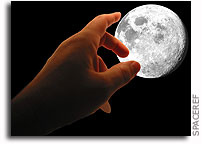The Hawaii Declaration of the Participants of the International Lunar Conference 16-22 November 2003

The Moon is currently the focus of an international program of scientific investigation. Current missions underway or planned will lead to the future use of the Moon for science and commercial development, thereby multiplying opportunities for humanity in space and on Earth. We need the Moon for many reasons: to use its resources of materials and energy to provide for our future needs in space and on Earth, to establish a second reservoir of human culture in the event of a terrestrial catastrophe, and to study and understand the universe. The next step in human exploration beyond low Earth orbit logically is to the Moon, our closest celestial neighbor in the Solar System.
Declaring this, we note large gaps in our understanding and knowledge must be addressed before the Moon can fully serve the noble purposes we identify. Many nations are conducting or planning lunar missions (ESA – SMART 1; Japan – Lunar A, SELENE; China – Chang’e; and India – Chandrayaan 1) that offer an opportunity for international cooperation fundamental for long-term public and private development and science. We strongly support the continued development of these missions. However, more knowledge is needed, requiring more complex capabilities than are now planned, including the first landings of spacecraft on the Moon since the Luna and Apollo programs of the 1960s and 1970s.
During the International Lunar Conference 2003, we identified a number of main thrusts for an expanded lunar program: assessment and use of potential ice / water resources at the lunar poles for human use; development of energy resources for both Moon and Earth and establishment of lunar astrophysical observatories. We have concluded that, for the future development of the Moon, the deposits of hydrogen indicated by the USA Clementine and Lunar Prospector missions must be fully understood to confirm their nature and importance for future planetary exploration, development and human settlement.
We recommend a sequence of technology, exploration and commercial missions on the road to this human Moon presence. We support the goals of a comprehensive series of missions including polar orbiters and landers, South Pole-Aitken Sample Return, Selene-B, Lunar Globe and Aurora lunar demonstrator. We advocate robotic engineering precursors for in-situ resource utilization and deployment of infrastructures preparing for human-tended operations.
To encourage and stimulate the peaceful and progressive development of the Moon, we recommend that the international community of national space agencies, companies and individuals operate and maintain an exploratory mission at a pole of the Moon to serve as a catalyst for future human missions within a decade.
Our vision is one of expanding humanity into space on an endless journey. We believe a human return to the Moon is the next step into the Solar System and the future of the human race. Aloha.
[signed]
- Niklolai Abrosimov, Marengo, Russia
- James R. Arnold, NASA Ames, USA
- Chen K. Arth, USA
- Ruiz Begoña, Colorado School of Mines, USA
- Jim Benson, SpaceDev, USA
- Narendra Bhandari, Physical Research Laboratory, India
- Brad Blair, Colorado School of Mines, USA
- Per Bodin, Swedish Space Corporation, Europe
- James D. Burke, NASA Jet Propulsion Laboratory (ret), USA
- Charles Bohannan, Space Age Publishing Company, USA
- Bill Carswell, NASA Marshall Space Flight Center, USA
- Wanda Carswell, USA
- Dan Casale, NASA Jet Propulsion Laboratory, USA
- Michael Cerney, Space Age Publishing Company, USA
- Robert Cesarone, NASA Jet Propulsion Laboratory, USA
- Patrick Collins, Azabu University, Japan
- Javier Diaz, Colorado School of Mines, USA
- Steve Durst, Space Age Publishing Company, USA
- Sidra Durst, USA
- Megan Fisher, student, USA
- Bernard Foing, European Space Agency, Europe
- Erik Galimov, Vernadsky Institute of Technology, Russia
- Alan Holt, NASA Johnson Space Center, USA
- Viacheslav Ivashkin, Keldysh Institute, Russia
- Eva Jane Lark, BMO Nesbitt Burns, Canada
- Paul D. Lowman, Jr., NASA Goddard Space Flight Center, USA
- Horst Uwe Keller, Max-Planck-Institut für Aeronomie, Europe
- Jonathan A. Kemp, USA
- Kurt Klaus, Boeing, USA
- Trygve Magelssen, University of North Dakota, USA
- Steve R. Martin, Lockheed Martin, USA
- Kohtaro Matsumoto, Japan Aerospace Exploration Agency, Japan
- Wendell Mendell, NASA Johnson Space Center, USA
- David P. Miller, University of Oklahoma, USA
- Gregory Nemitz, Orbdev, USA
- Manny Pimenta, Space Frontier Foundation, USA
- James Powell, Maglev 2000, USA
- Guiseppe Racca, European Space Agency, Europe
- Jesus Raygoza B., Mexico
- Robert Richards, Optech, Canada
- Carol Rosin, Institute for Cooperation in Space, USA
- Eligar Sadeh, University of North Dakota, USA
- Christian Sallaberger, MD Robotics, Canada
- David Schrunk, Science of Laws Institute, USA
- Robert Strong, West Liberty State College, USA
- Paul D. Spudis, John Hopkins University, USA
- Yuki Takahashi, University of California Berkeley, USA
- Lawrence Taylor, University of Tennessee, USA
- Chris Thomason, Space Age Publishing Company, USA
- Roger Thomasson, USA
- Ting Ting Martin, USA
- Paul van Susante, Colorado School of Mines, USA
- Leilehua Yuen, Hawaii Island Space Exploration Society, USA
- Tamani Yotsukura, Space Business Art, Japan








